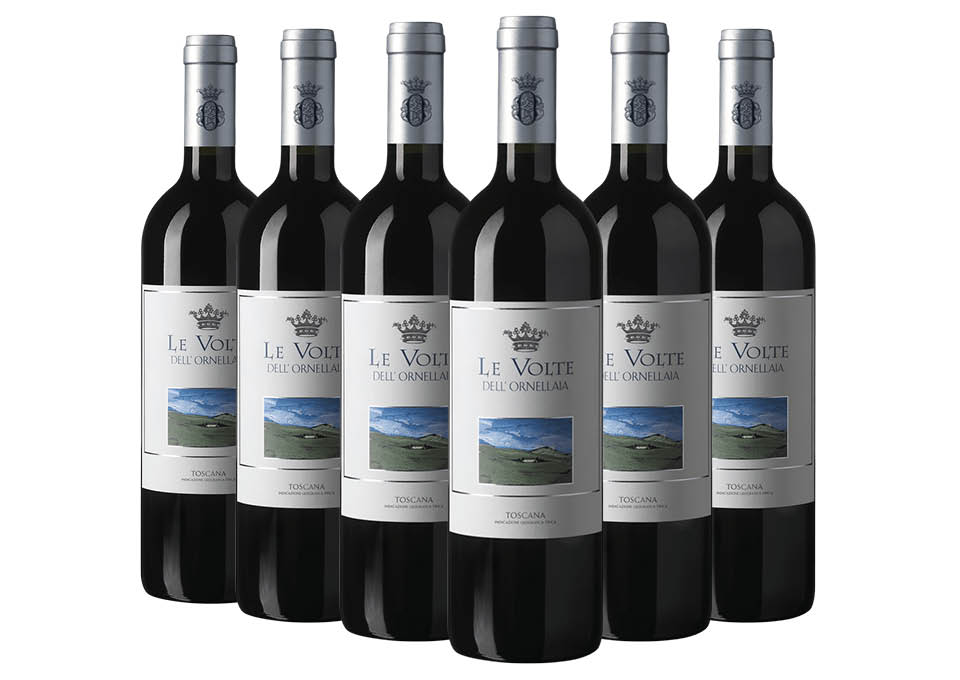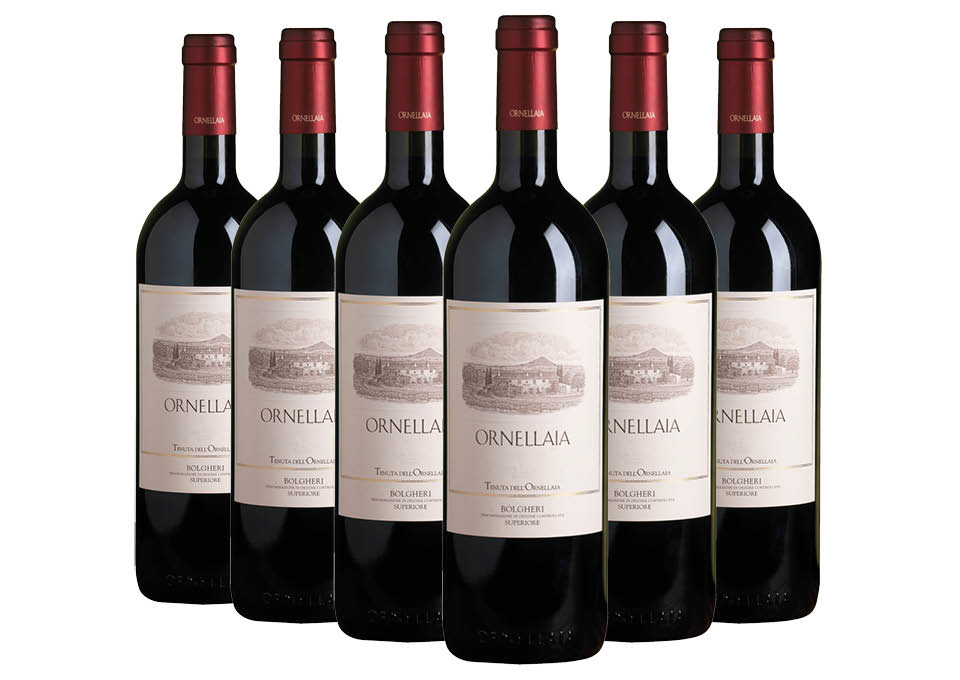Ornellaia, Tuscany
The history of Ornellaia is intertwined between the most important names and personalities of the world wine and wine scene: from Tchelistcheff to Michel Roland, from Robert Mondavi to Thomas Duroux, up to the current Axel Heinz, passing ownership from the Antinori - who founded the held in 1981 with Ludovico Antinori - to the Frescobaldi, who acquired it in the early 2000s. A story that is indissolubly linked to that of the Bolgheri terroir, contributing to the development and growth of one of the most discussed wine-growing areas in Italy. Some years are particularly significant for Ornellaia such as 1985, the first vintage of Ornellaia wine, or 1993 which saw the birth of the young red Le Volte dell'Ornellaia, or 2015, the release vintage of Ornellaia's 30th anniversary in a precious pack to celebrate this event.
Ornellaia: in the cradle of Bolgheri
Ornellaia's wines all derive from the approximately 100 hectares of its own vineyards, located in a happy position a few kilometers from the coast and at the foot of the hills, and produced with obsessive attention to every single step of the vinification and where the selection of grapes is essence of wine itself. A fil rouge has accompanied the production in Ornellaia for almost 40 years, from the vineyard to the marketing and it is the prestige, the prestige of creating wines that are now cult for great enthusiasts from all over the world. Luxury wines that have themselves become the essence of luxury, and which have surpassed the fame of the Bolgheri appellation to enter the myth.
The secret of Ornellaia's red wine lies in the attention to every detail.
Attention to every detail is the secret of Ornellaia's red wine and concerns all stages of production, from the harvest, with the double selection of the bunches, to the vinification stage, with a vinification and aging of one year made separately for each cru, in order to bring out the specific characteristics of each vineyard of origin in the final blend. Maniacal attention even when the wines are chosen for the cuvées, among over 70/80 base wines, in the obsession to best express the elegance inherent in the spirit of Ornellaia and the style of the vintage.
Is it true that Ornellaia Masseto 2017 is considered a great vintage?
The Ornellaia Masseto 2017, while failing to match the infinite greatness of 2016, is still considered one of the best vintages of the decade, destined to improve with an aging of up to 15 years and beyond, in the cellar of all its lucky owners.
Who are the current owners of the Ornellaia winery?
The current owners of the Ornellaia winery are the Marquises Frescobaldi, who have been engaged in wine for 700 years and currently also owners of the ATTEMS (Friuli) MASSETO, DANZANTE, LUCE DELLA VITE estates, as well as of course the six historic estates: FRESCOBALDI Nipozzano, CastelGiocondo, Pomino, Flagship, Castiglioni and Remole.

Tuscan wines are, together with those of Piedmont and Veneto, the most famous Italian wines in the world: great excellences such as Brunello di Montalcino, Bolgheri (primarily Sassicaia Bolgheri Doc) and Supertuscan have made known the excellence of made in Italy in the world. In Tuscany, Sangiovese and indigenous grapes are the protagonists alongside international grapes such as Cabernet and Merlot, in a territory that, like no other, seems to have been born on purpose to produce excellent wines. If a legend widespread at the time of the Medici told that Noah with his ark landed in Tuscany and planted the first vine cuttings, what is certain is that in Tuscany the winemaking tradition is so ancient that, unlike other regions, it surpasses the Romans and the Greeks and reaches up to the Etruscan civilization.
Tuscan red wine? A well-stocked cellar cannot be missing.
Tuscan red wines are the red wines for aging par excellence: Brunello di Montalcino has a longevity that exceeds 20 years, and great surprises in this sense also reserve the Nobile di Montepulciano and Carmignano, less known appellations but of ancient tradition, born from the union of Sangiovese with Cabernet Franc brought to Italy by Caterina de 'Medici. However, Tuscan red wine is also synonymous with conviviality, with Chianti in all its nuances, from the traditional flask to the magnum bottles in wooden boxes of the great selections, and above all with Morellino di Scansano, a wild Sangiovese from Maremma. Last but not least other small appellations such as Sant'Antimo Doc, Rosso di Montalcino and Montecucco, in which Sangiovese is and remains the true protagonist. Finally, some producers have tried their hand at Tuscany with the most cursed of the grapes, Pinot Noir, obtaining very interesting results.
Tuscan white wines: a less known reality to be discovered
In Tuscany there is only one Tuscan DOCG white: Vernaccia di San Gimignano. Born from native grapes, it is said that the wine that cuts and pricks was the favorite of the greatest Florentine genius: Michelangelo Buonarroti. Then there are numerous DOC and IGT appellations, which see Vermentino excel, aged in steel or wood, alongside international grapes such as chardonnay and sauvignon. Trebbiano toscano is another widespread grape variety, which combined with malvasia gives life to the famous Vin Santo, in its various and precious golden declinations such as Vin Santo del Chianti Classico and Vin Santo Occhio di Pernice.
What is the finest Tuscan wine?
The most famous Tuscan red, Chianti Classico, links an ancient legend to its main symbol, the black rooster. In fact, it is said that the cities of Siena and Florence had to decide the territorial boundaries by bringing together two knights, both departed to the crowing of the cock, white for the Sienese and black for the Florentines. The Florentines, much more cunning, kept their black rooster stiff, locked in the cage, in the two days preceding the competition and the poor animal, in a panic, opened the cage immediately went out to sing, even if it was the middle of the night. This early departure with respect to dawn allowed Florence to establish the boundary of its province near the city of Siena, where it still is today, in the heart of the Chianti area.
Which is the longest-lived Tuscan DOCG red wine?
The longest-lived Tuscan DOCG red wine is undoubtedly Brunello : it manages to evolve in the cellar even for more than 20 years, developing extraordinary aromas and thus becoming one of the best meditation red wines in the world.
What is the best Tuscan white wine to pair with fish dishes?
The best Tuscan white wine to combine with fish menus is definitely Vermentino which, born from the vineyards caressed by the sea breezes, manages to enhance seafood dishes thanks to its natural flavor and freshness. Seeing is believing!








